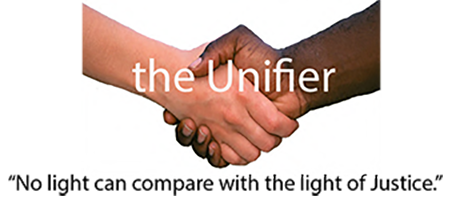
In proclaiming the oneness of mankind He (Bahá’u’lláh) taught that men and women are equal in the sight of God and that there is no distinction to be made between them. The only difference between them now is due to lack of education and training. If woman is given equal opportunity of education, distinction and estimate of inferiority will disappear.
“The world of humanity has two wings, as it were: One is the female; the other is the male. If one wing be defective, the strong perfect wing will not be capable of flight. …God is the Creator of mankind. He has endowed both sexes with perfections and intelligence, given them physical members and organs of sense, without differentiation or distinction as to superiority; therefore, why should woman be considered inferior? This is not according to the plan and justice of God.”
“He has created them equal; in His estimate there is no question of sex. The one whose heart is purest, whose deeds are most perfect, is acceptable to God, male or female. Often in history women have been the pride of humanity — for example, Mary, the mother of Jesus. She was the glory of mankind. Mary Magdalene, Asiyih, daughter of Pharaoh, Sarah, wife of Abraham, and innumerable others have glorified the human race by their excellences.“

“In this day there are women among the Bahá’ís who far outshine men. They are wise, talented, well-informed, progressive, most intelligent and the light of men. They surpass men in courage. When they speak in meetings, the men listen with great respect.“
“Furthermore, the education of women is of greater importance than the education of men, for they are the mothers of the race, and mothers rear the children. The first teachers of children are the mothers. Therefore, they must be capably trained in order to educate both sons and daughters. There are many provisions in the words of Bahá’u’lláh in regard to this.” ‘Abdu’l-Bahá
In the above analogy, ‘Abdu’l-Bahá illustrates Bahá’u’lláh’s principle of the innate equality of women and men, the reason why this innate reality isn’t manifest in the world (the lack of equal education) and the fact that society will never be able to fully develop without both wings, female and male, being of equal strength.
Since Bahá’u’lláh wrote in the late 1800’s and ‘Abdu’l-Bahá in the late 1800’s and early 1900’s, equal education for women has become a reality in most of the industrialized nations of the planet, even though not all members of society have allowed women to partake of all the benefits of that education. At the same time, many other nations still provide less of an education to women or continue to outright deny them an education of even the most rudimentary level.
In the Gender category of this blog site we will explore both the general condition of women today and delve into many sub-categories such as the Philosophical/Religious underpinnings of Female/Male Socialization, the mistreatment of Minority Women, the fight for the vote, equal pay for equal work, reproductive rights, and many more.
To make a beginning, let’s ask the question, “Has gender inequality always been an aspect of human thought and society?” It’s a good question to ponder, but also one for which we will never have a definitive answer. We do know that, according to Historian Gerda Lerner and others, there is evidence for gender inequalities in, at least some of, the middle eastern societies of the second century BCE. So, we might ask, how far back in time can we find evidence of inequality?
There was a study published a while back in the European Journal of Archaeology by two Archaeologists Marta Cintas-Peña and Leonardo Garcia Sanjuán from the University of Seville, Spain, who wanted to know the answer to that question. They conducted research into twenty-one different sites located on the Iberian Peninsula (Spain & Portugal) looking for patterns in the burial practices of the people who had once lived there during Neolithic times, some 5,000 – 8,000 years ago. They found the burial sites of approximately 500 individuals, but could only identify the gender of 198 of them. They looked at individual graves, pit graves and collective graves and found more men than women or children. From what they were seeing they felt that the number of men was overrepresented and felt that this couldn’t have been due to natural causes and drew the conclusion that the males were benefiting from preferential treatment.
I’m not an Archaeologist, not even a practicing scientist, though I do have a bachelor’s degree in Anthropology, however, I wonder if the elevated male count might be due to gender roles, specifically the role of hunter, and possibly even warrior, rather than gender preferences in burial practices. Cintas-Pena and Sanjuán suggest that women and children might not have warranted a formal burial on the same par as males, but then they studied pit and collective graves as well as individual graves, so in my mind their conclusion seems wrong.

They also looked at the typical objects that were buried along with the bodies and found, what I would think was, and still is, a connection to the stratified social role each gender played – arrowheads for the male hunters and ceramics for the female tenders of the family. Lastly, they looked at cave art from the time and noted the abundance of male images engaged in hunting and war. In this case, I would agree that a clear preference or bias is apparent. At its fundamental base these cave art depictions are the “Action” movies of their day. The reason they were produced on cave walls, and are produced today in the movie theaters and home theaters is that there is an appetite for them. Today, we say that appetite is that of the thirteen year old male, but then men and women of all ages end up watching them and Hollywood keeps producing them. Cintas-Peña wrote, “All of the evidence that we found in some way linked to the predominance of men in terms of violence. There was a difference in power and this difference in power maybe was based in the use of violence by males.” It is here that I would bring up the old “Nature or Nurture” question. Are males more innately violent than women, or are they trained to be so? Did early humans notice that higher numbers of women were being killed in hunting activities and in war parties, and therefore began to limit their participation in those activities? And, then like now, did the hunters and warriors become desensitized to the violence that surrounded them? Did early naturalist religion, and honoring the kill, develop as a result of hunters feeling guilty over killing animals? Just as unfortunate is that no matter how human inequality, be it gender, racial, etc., developed, it is still with us today, and it isn’t easy to eliminate. It has been with us for so long that great numbers of people now believe that it is just a normal part of being human and can’t be eliminated. As you can see from the quote that began this post, there are those who humbly disagree and seen gender inequality as an abnormality that today can be eliminated through hard and committed work firmly based on, and in, education. Not only must all be educated to the possibly of equality between the genders, but most importantly, women must be educated so that in the terms of the analogy employed above, the strength of their wing will become co-equal to that of men.
Unfortunately, what we call the “dim past” is just that. Prehistoric means prewritten, and only a few of the great oral tales of those ages have crossed over into the written word, what once the story-tellers recited from memory around the campfire, became Homer’s ‘Odyssey’ or ‘Iliad’, the ‘Tale of Gilgamesh’, the ‘Vedas’ and the ‘Pentateuch’. All others have faded into the mist.
Just as unfortunate is that no matter how human inequality, be it gender, racial, etc., developed, it is still with us today, and it isn’t easy to eliminate. It has been with us for so long that great numbers of people now believe that it is just a normal part of being human and can’t be eliminated. As you can see from the quote that began this post, there are those who humbly disagree and seen gender inequality as an abnormality that today can be eliminated through hard and committed work firmly based on, and in, education. Not only must all be educated to the possibly of equality between the genders, but most importantly, women must be educated so that in the terms of the analogy employed above, the strength of their wing will become co-equal to that of men.
Notice how the quote says ‘now’, The only difference between them now is due to lack of education and training. If woman is given equal opportunity of education, distinction and estimate of inferiority will disappear. Now, it doesn’t matter how we got here, as much as it matters what we do to correct the deficiencies that now exist.
The education of women is also the answer to the question of how we break the cycle of gender inequality. ‘Abdu’l-Bahá writes, “Furthermore, the education of women is of greater importance than the education of men, for they are the mothers of the race, and mothers rear the children. The first teachers of children are the mothers. Therefore, they must be capably trained in order to educate both sons and daughters.” When women are educated in all subjects, including how to socialize young children the ‘sons’ as well as the ‘daughters’ will be the beneficiaries.
One of the most egregious barriers to that desired education are philosophies and regimes such as the Taliban in Afghanistan who mistreat and even kill young women who want to be educated. There are undoubtedly many social traits to the people of Afghanistan that should be retained and treasured, however, there are other social traits that desperately need to be abandoned and relegated to the dust bin of history.
https://youtu.be/c2DHzlkUI6s Malala Yousafzai giving her Nobel Prize acceptance speech.


